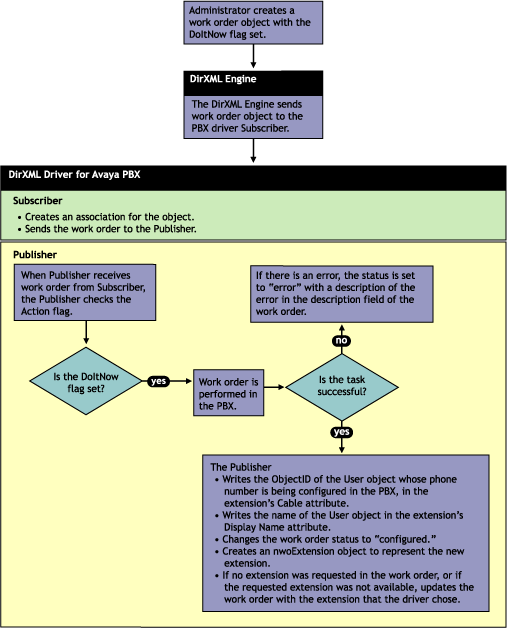How the Base Configuration Works
Figure 5 shows what happens in the base configuration if you create an nwoWorkOrder object for installing a new extension.
- You create an nwoWorkOrder object in eDirectory with the task "Install." In this example, the flags are set on the work order for SendToPublisher and DoItNow.
- The Subscriber channel is notified by the DirXML Engine that a new nwoWorkOrder object has been created in eDirectory.
- The Subscriber creates the DirXML association for the object, and sends the work order to the Publisher.
(If the SendToPublisher flag were not set, the Subscriber would not "wake up" Publisher channel to send the work order to the Publisher. Instead, the Publisher would read the work order the next time it polled for work orders.)
- The Publisher performs the work order immediately, because the DoItNow flag is set.
(If the DoItNow flag were not set, the Publisher wouldn't perform the action until the date specified in the DueDate attribute.)
- After successfully configuring the extension in the PBX, the Publisher writes "configured" in the Status attribute of the work order.
- The Publisher creates a pbxExtension object in eDirectory to represent the new extension that has been configured.
After the driver completes the work order in the PBX, the PBX admin can complete any manual tasks required, such as plugging in the phone and punching in the activation code for hot jacks, or cross-connecting the wiring, etc., for cold jacks.
The following figures describe the base configuration. Figure 5 shows an illustration of generally how the base configuration works. Figure 6 is a flowchart of how the configuration works for an Install work order with the DoItNow flag set to true, and Figure 7 is a flowchart showing how the configuration works for an Install work order with the DoItNow flag not set.
Figure 5Graphical Representation of Base Configuration
 Figure 6
Figure 6 Flowchart of Base Configuration for Work Order with DoItNow Flag Set to True
 Figure 7
Figure 7 Flowchart of Base Configuration for Work Order with DoItNow Flag Not Set

How the Subscriber Channel is Configured
In the base configuration, the Subscriber channel processes only events that pertain to work orders.
You must create pbxSite objects for each site in eDirectory, so the driver knows how to contact each PBX, but the driver queries for this information only at startup. The Subscriber does not listen for events pertaining to pbxSite objects, so if changes are made to these objects you must stop and restart the driver for the changes to be recognized by the driver.
For many drivers, the Subscriber performs changes in the third-party application in response to events in eDirectory. However for this driver, the Publisher is the agent which performs work orders in the PBX.
| Rule or Style Sheet | What it does |
|---|---|
Subscriber Filter |
Allows only events for nwoWorkOrder objects to be processed. |
Event Transformation |
Not used in sample configuration. |
Matching Rule |
Not used in sample configuration. |
Create Rule |
Contains rules only for work order objects. Requires values for the following attributes on a work order object.
If they are not present, the work order is not sent to the Publisher, and therefore is not performed in the PBX. For a description of these attributes, see DirXML-nwoWorkOrder Object. |
Placement Rule |
Maps work orders from the work order container you specified to the PBX driver. This mapping is necessary so that the Subscriber can check the work orders to see whether the DoItNow flag is set to True. |
Command Transformation |
Not used in sample configuration. |
Schema Mapper |
Maps eDirectory namespace to PBX namespace. Handles mapping of work orders, extensions, and PBX site objects. |
Output Transformation |
Not used in sample configuration. |
How the Publisher Channel is Configured
Through the Publisher Channel, the Identity Manager Driver for Avaya PBX queries the PBX for information about extensions. The Publisher is the one that performs tasks in the Avaya PBX, rather than the Subscriber. For a general overview of what the Publisher does, see Overview of Driver Functionality.